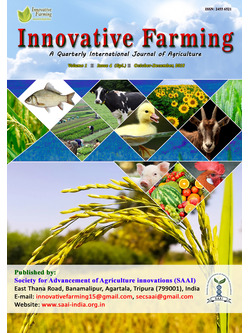
Prosopis juliflora: A Tree for Rehabilitating Salt Affected Soils
Vijayata Singh*
Central Soil Salinity Research Institute, Karnal, Haryana-132001, INDIA
Jogendra Singh
Central Soil Salinity Research Institute, Karnal, Haryana-132001, INDIA
T.V. Vineeth
Central Soil Salinity Research Institute, Karnal, Haryana-132001, INDIA
P.C. Sharma
Central Soil Salinity Research Institute, Karnal, Haryana-132001, INDIA
DOI: NIL
Keywords: Prosopis juliflora, Agroforestry, Rehabilitization
Abstract
The earth is experiencing a faster change in climate in the 21st century than it had in the past. Abiotic stresses such as drought and salinity, exacerbated by the fast changing climatic conditions pose a major hurdle in sustaining crop productivity. High salt concentration in the soil is a serious problem in vast areas of otherwise productive agricultural lands in India. Establishment of salt tolerant vegetation could be an effective way of ameliorating this problem. Prosopis juliflora has a lot of potential for rehabilitating and management of salt affected soils. Being a source of fuel, small timber wood and in some cases used as dry season fodder, Prosopis is playing a vital role in sustaining the livelihoods of the rural poor, society with disadvantaged resources including the landless labourers, small farmers and artisans in dry regions.
Downloads
not found
Reference
ElFadl, M. A., and Luukkanen, O. (2003). Effect of pruning on Prosopis juliflora: Considerations for tropical dryland agroforestry. Journal of Arid Environments, 53(4), 441–455.
Felker, P., and Bandurski, R. S. (1979). Uses and potential uses of leguminous trees for minimal energy input agriculture. Economic Botany, 33(2), 172–184.
Pasiecznik, N. M., Felker, P., Harris, P. J. C., Harsh, L. N., Cruz, G., Tewari, J. C., Cadoret, K., and Maldonado, L. J. (2001). The Prosopis juliflora–Prosopis pallida Complex: A Monograph. HDRA, Coventry, UK, pp. 162.
Qadir, M., Tubeileh, A., Akhtar, J., Larbi, A., Minhas, P. S., and Khan, M. A. (2008). Productivity enhancement of salt-affected environments through crop diversification. Land Degradation & Development, 19, 429–453.
Singh, G., Abrol, I. P., and Cheema, S. S. (1988). Agroforestry on alkali soil: Effect of planting methods and amendments on initial growth, biomass accumulation and chemical composition of mesquite (Prosopis juliflora (SW) DC) with inter-space planted with and without Karnal grass (Diplachne fusca Linn. P. Beauv.). Agroforestry Systems, 7, 135–160.
Singh, G., Singh, N. T., and Dagar, J. C. (1993). Agroforestry in salt-affected soils. Technical Bulletin No. 17, CSSRI, Karnal, India, pp. 65.
